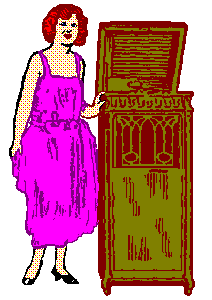Victor Orthophonic vs. Edison Edisonic - A Comparison
By Peter Fraser

Q: You know what I'd love to hear? A side-by-side comparison of the Orthophonic Victrola with the Edisonic. The Edisonic had an enlarged horn and chamber, but I assume the proportions were different from those of the Orthophonic.
Well, we own a Credenza (the largest-horn Orthophonic machine Victor produced for the public), as well as an Edison Diamond Disc machine with the 250-size horn and an Edisonic reproducer, so we can approximate the comparison. The results in a moment, but first this background discussion . . .
 The genesis of the Edisonic is interesting. When the first Diamond Disc units were released to the public, Edison received complaints that the sound produced was too loud. This stimulated the addition of sound modifiers, culminating in the familiar cable-operated mute ball, to the Diamond Disc units. A decade later, with the 20's dance craze in full swing, Edison was prompted to again give the public what they wanted - this time with the "Dance" reproducer, which produced more volume than the original via a heavier tracking weight. The intent of this device was to yield larger volume for dancing in the home or small halls - but at the cost of increased distortion. Users were directed to use each type of repoducer for the specific listening/dancing situation. The genesis of the Edisonic is interesting. When the first Diamond Disc units were released to the public, Edison received complaints that the sound produced was too loud. This stimulated the addition of sound modifiers, culminating in the familiar cable-operated mute ball, to the Diamond Disc units. A decade later, with the 20's dance craze in full swing, Edison was prompted to again give the public what they wanted - this time with the "Dance" reproducer, which produced more volume than the original via a heavier tracking weight. The intent of this device was to yield larger volume for dancing in the home or small halls - but at the cost of increased distortion. Users were directed to use each type of repoducer for the specific listening/dancing situation.
 When the Orthophonic system of machines and records was introduced in late '25, the Edison people were quick to check out the competition. While doing research at the Edison site with Ron Dethlefson in the spring of '95, this was one of the topics I investigated. I have copies of several reports to the management, which basically summarize the entire new technology as merely producing more volume and little else. Any effects of electrical recording, a key element, are minimized, with emphasis on this and other aspects (thin metal diaphragm with spider, exponential horn, etc) of the Ortho system dismissed as techno-babble. They therefore missed the boat in the areas of increased frequency response and reduced distortion, although this may merely be a few cases of telling the boss what he wants to hear. When the Orthophonic system of machines and records was introduced in late '25, the Edison people were quick to check out the competition. While doing research at the Edison site with Ron Dethlefson in the spring of '95, this was one of the topics I investigated. I have copies of several reports to the management, which basically summarize the entire new technology as merely producing more volume and little else. Any effects of electrical recording, a key element, are minimized, with emphasis on this and other aspects (thin metal diaphragm with spider, exponential horn, etc) of the Ortho system dismissed as techno-babble. They therefore missed the boat in the areas of increased frequency response and reduced distortion, although this may merely be a few cases of telling the boss what he wants to hear.
The response by Edison was of course the Edisonic units, both reproducer and machine: a new development of the Dance, this time with the big weight plus a pre-loading counterspring on the stylus bar and diaphragm (released in early 1927), as well as machines with larger, although still basically conical, horns (released in late 1927). Result: more volume and bass response. Still later, Edison did record Diamond Disks electrically, and the combination of the Edisonic reproducer and big horn with the fuller response of an electrical Diamond Disc is what we should compare to a Victor Scroll played on a Credenza.
Now, having said all that, how do they compare today? Not a truly scientific test, to be sure - but both units are in good shape, with both reproducers rebuilt to exacting standards by the Wizard of Wondertone, Mr. Bob Waltrip (email me for contact information). Since identical performances are not available on both record formats, we must settle for roughly contemporary (1928) electrical recordings by each manufacturer. And of course there's no accounting for taste . . . very subjective.
 Results? Technically, the Credenza kills . . . but the Diamond Disc gives it a real run for its money. The big Victor has what is essentially an optimized 6-foot long horn, expanding in cross-sectional area along mathematically determined guidelines, although folded and compressed to fit into the big Credenza box. This produces pretty whomping bass - especially on numbers with tuba rhythm accompaniment. And the high end is rather crisp and sparkles on tunes with triangles and bells and high-hats . . . but the Edison has a clarity and inexplicable warmth that at least partially transcends the other. Bass response would be enhanced by the larger Edisonic horn that we lack at our house, but overall performance is fine, with good definition and low distortion even at the highest levels. As some have said, the sound of a diamond disc feels like it "follows you down the hall," while the Ortho just fills the room with the tune. Results? Technically, the Credenza kills . . . but the Diamond Disc gives it a real run for its money. The big Victor has what is essentially an optimized 6-foot long horn, expanding in cross-sectional area along mathematically determined guidelines, although folded and compressed to fit into the big Credenza box. This produces pretty whomping bass - especially on numbers with tuba rhythm accompaniment. And the high end is rather crisp and sparkles on tunes with triangles and bells and high-hats . . . but the Edison has a clarity and inexplicable warmth that at least partially transcends the other. Bass response would be enhanced by the larger Edisonic horn that we lack at our house, but overall performance is fine, with good definition and low distortion even at the highest levels. As some have said, the sound of a diamond disc feels like it "follows you down the hall," while the Ortho just fills the room with the tune.
So, a conclusion? To each listener there will be choices to make. If I had to pick, I couldn't! That's why we have both. I think the top Edison has a slight edge enjoyment-wise, but is hampered by the severely limited range of good material on record. When I want to hear hot music, I play the Credenza - there's tons of good stuff to play on it, and it really has impact - but when I want to listen I sit down in front of our Diamond Disc machine.
Hope this helps - just one guy's opinion!
-
- - Peter Fraser

Return to the W.A.M.S. Home Page |
 The genesis of the Edisonic is interesting. When the first Diamond Disc units were released to the public, Edison received complaints that the sound produced was too loud. This stimulated the addition of sound modifiers, culminating in the familiar cable-operated mute ball, to the Diamond Disc units. A decade later, with the 20's dance craze in full swing, Edison was prompted to again give the public what they wanted - this time with the "Dance" reproducer, which produced more volume than the original via a heavier tracking weight. The intent of this device was to yield larger volume for dancing in the home or small halls - but at the cost of increased distortion. Users were directed to use each type of repoducer for the specific listening/dancing situation.
The genesis of the Edisonic is interesting. When the first Diamond Disc units were released to the public, Edison received complaints that the sound produced was too loud. This stimulated the addition of sound modifiers, culminating in the familiar cable-operated mute ball, to the Diamond Disc units. A decade later, with the 20's dance craze in full swing, Edison was prompted to again give the public what they wanted - this time with the "Dance" reproducer, which produced more volume than the original via a heavier tracking weight. The intent of this device was to yield larger volume for dancing in the home or small halls - but at the cost of increased distortion. Users were directed to use each type of repoducer for the specific listening/dancing situation. When the Orthophonic system of machines and
When the Orthophonic system of machines and  Results? Technically, the Credenza kills . . . but the Diamond Disc gives it a real run for its money. The big Victor has what is essentially an optimized 6-foot long horn, expanding in cross-sectional area along mathematically determined guidelines, although folded and compressed to fit into the big Credenza box. This produces pretty whomping bass - especially on numbers with tuba rhythm accompaniment. And the high end is rather crisp and sparkles on tunes with triangles and bells and high-hats . . . but the Edison has a clarity and inexplicable warmth that at least partially transcends the other. Bass response would be enhanced by the larger Edisonic horn that we lack at our house, but overall performance is fine, with good definition and low distortion even at the highest levels. As some have said, the sound of a diamond disc feels like it "follows you down the hall," while the Ortho just fills the room with the tune.
Results? Technically, the Credenza kills . . . but the Diamond Disc gives it a real run for its money. The big Victor has what is essentially an optimized 6-foot long horn, expanding in cross-sectional area along mathematically determined guidelines, although folded and compressed to fit into the big Credenza box. This produces pretty whomping bass - especially on numbers with tuba rhythm accompaniment. And the high end is rather crisp and sparkles on tunes with triangles and bells and high-hats . . . but the Edison has a clarity and inexplicable warmth that at least partially transcends the other. Bass response would be enhanced by the larger Edisonic horn that we lack at our house, but overall performance is fine, with good definition and low distortion even at the highest levels. As some have said, the sound of a diamond disc feels like it "follows you down the hall," while the Ortho just fills the room with the tune.